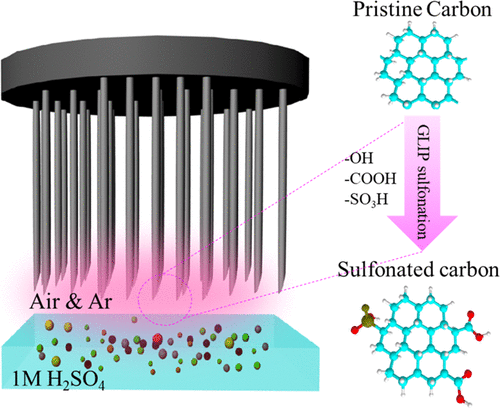当前位置:
X-MOL 学术
›
ACS Sustain. Chem. Eng.
›
论文详情
Our official English website, www.x-mol.net, welcomes your
feedback! (Note: you will need to create a separate account there.)
Green Sulfonation of Carbon Catalysts via Gas–Liquid Interfacial Plasma for Cellulose Hydrolysis
ACS Sustainable Chemistry & Engineering ( IF 7.1 ) Pub Date : 2020-04-06 , DOI: 10.1021/acssuschemeng.9b07156 Lusha Qin 1 , Takahiro Ishizaki 2 , Nozomi Takeuchi 3 , Katsuyuki Takahashi 4 , Kwang Ho Kim 1, 5 , Oi Lun Li 1
ACS Sustainable Chemistry & Engineering ( IF 7.1 ) Pub Date : 2020-04-06 , DOI: 10.1021/acssuschemeng.9b07156 Lusha Qin 1 , Takahiro Ishizaki 2 , Nozomi Takeuchi 3 , Katsuyuki Takahashi 4 , Kwang Ho Kim 1, 5 , Oi Lun Li 1
Affiliation

|
Sulfonated carbon catalysts exhibit excellent catalytic performance for biomass transformation, yet most currently used sulfonation approaches still rely on concentrated sulfuric acid or chlorsulfuron acid and harsh reaction conditions. Herein, we investigate a “green” sulfonation system via a novel gas–liquid interfacial plasma (GLIP) process conducted in 1 M H2SO4 at 25 °C for carbon materials with diverse surface properties, including carbon nanotubes (CNTs), reduced graphene oxide (RGO), and activated carbon (AC). The sulfonic acid and total acid group densities of carbon acid catalysts are in the ranges of 0.36–0.59 and 3.47–3.63 mmol g–1, respectively, which are comparable to those of other carbon acid catalysts reported in the literature. In terms of the catalytic ability of cellulose conversion, GLIP-sulfonated carbon catalysts exhibit catalytic activity similar to that of those prepared by a hydrothermal method with concentrated H2SO4 under an identical cellulose hydrolysis process. Further, all GLIP-sulfonated carbons exhibit high recyclability of 96.6–98.2% after three consecutive runs. The performance of GLIP sulfonation is attractive thanks to the plasma-induced reactions at the gas–liquid interface, by which plasma discharge-induced active species (•OH, •H, SO3, electrons, etc.) graft the defects and edges of carbon materials directly without causing severe damage to the carbon structure. This study presents an innovative, “green”, and universal sulfonation process for synthesizing carbonaceous acid catalysts for biomass transformation.
中文翻译:

气液界面等离子体对碳催化剂进行绿色磺化纤维素水解
磺化碳催化剂对生物质的转化表现出优异的催化性能,但是大多数当前使用的磺化方法仍然依赖于浓硫酸或氯磺隆酸以及苛刻的反应条件。本文中,我们通过新颖的气液界面等离子体(GLIP)工艺在25°C的1 MH 2 SO 4中进行了“绿色”磺化系统的研究,以处理具有多种表面特性的碳材料,包括碳纳米管(CNT),还原石墨烯氧化物(RGO)和活性炭(AC)。碳催化剂的磺酸和总酸基密度在0.36–0.59和3.47–3.63 mmol g –1的范围内分别与文献中报道的其他碳酸催化剂相当。就纤维素转化的催化能力而言,GLIP-磺化碳催化剂的催化活性与在相同的纤维素水解过程中用浓H 2 SO 4的水热法制备的那些具有相似的催化活性。此外,在连续三轮运行后,所有GLIP磺化碳均显示出96.6–98.2%的高可回收性。GLIP磺化的性能非常诱人,这归功于等离子体在气液界面上引起的反应,通过等离子体反应,等离子体放电引起的活性物质(• OH,• H,SO 3,电子等)直接嫁接碳材料的缺陷和边缘,而不会严重破坏碳结构。这项研究提出了一种创新的“绿色”通用磺化方法,用于合成用于生物质转化的碳酸催化剂。
更新日期:2020-04-23
中文翻译:

气液界面等离子体对碳催化剂进行绿色磺化纤维素水解
磺化碳催化剂对生物质的转化表现出优异的催化性能,但是大多数当前使用的磺化方法仍然依赖于浓硫酸或氯磺隆酸以及苛刻的反应条件。本文中,我们通过新颖的气液界面等离子体(GLIP)工艺在25°C的1 MH 2 SO 4中进行了“绿色”磺化系统的研究,以处理具有多种表面特性的碳材料,包括碳纳米管(CNT),还原石墨烯氧化物(RGO)和活性炭(AC)。碳催化剂的磺酸和总酸基密度在0.36–0.59和3.47–3.63 mmol g –1的范围内分别与文献中报道的其他碳酸催化剂相当。就纤维素转化的催化能力而言,GLIP-磺化碳催化剂的催化活性与在相同的纤维素水解过程中用浓H 2 SO 4的水热法制备的那些具有相似的催化活性。此外,在连续三轮运行后,所有GLIP磺化碳均显示出96.6–98.2%的高可回收性。GLIP磺化的性能非常诱人,这归功于等离子体在气液界面上引起的反应,通过等离子体反应,等离子体放电引起的活性物质(• OH,• H,SO 3,电子等)直接嫁接碳材料的缺陷和边缘,而不会严重破坏碳结构。这项研究提出了一种创新的“绿色”通用磺化方法,用于合成用于生物质转化的碳酸催化剂。











































 京公网安备 11010802027423号
京公网安备 11010802027423号